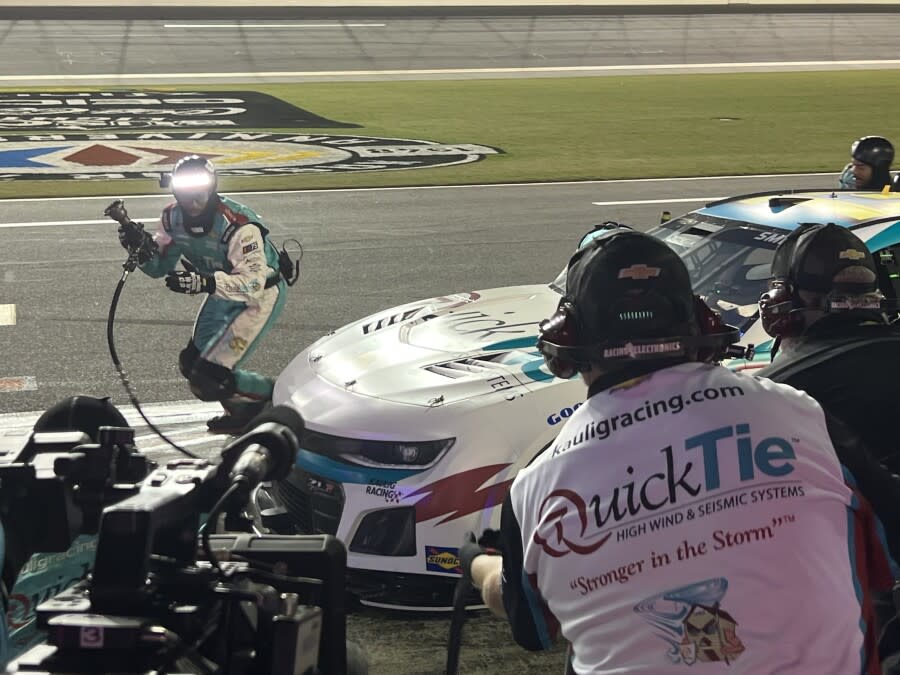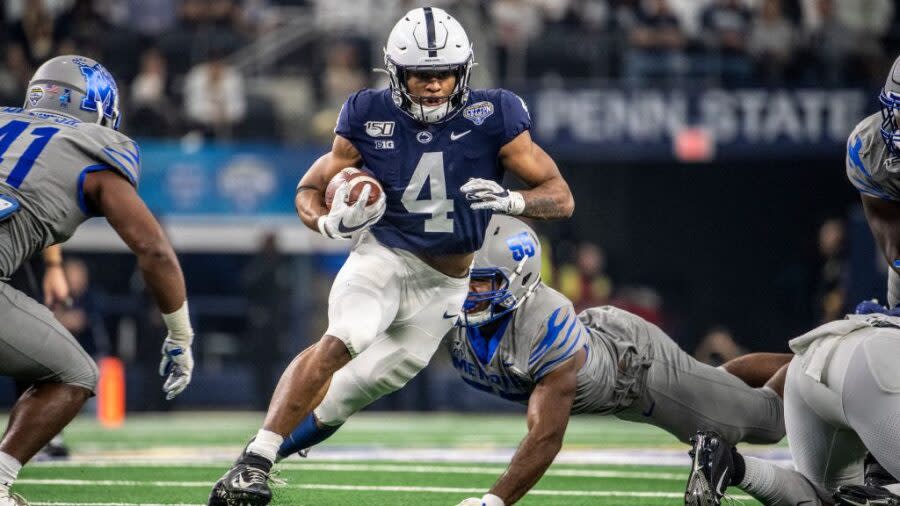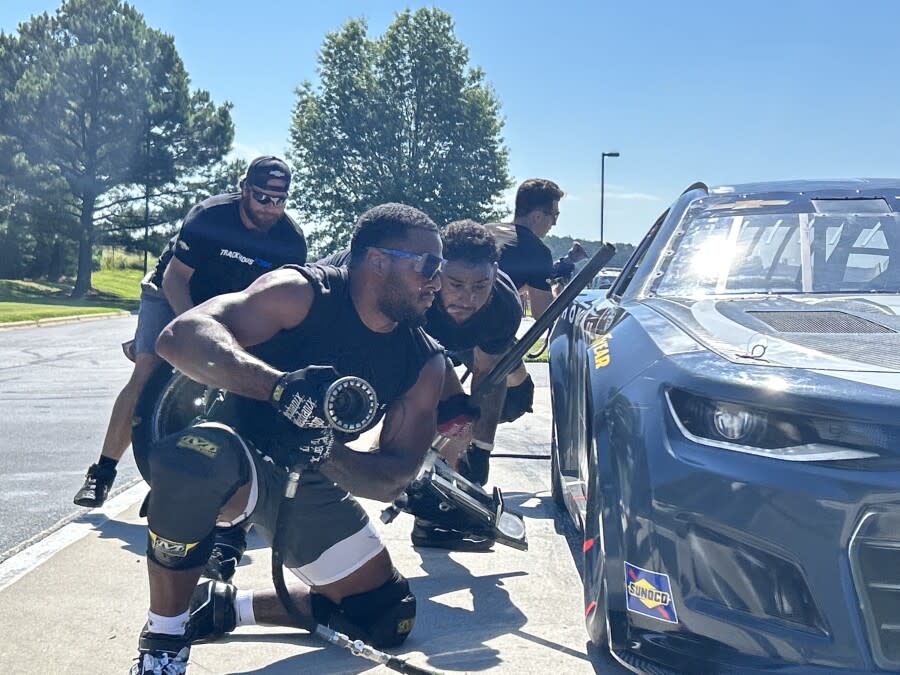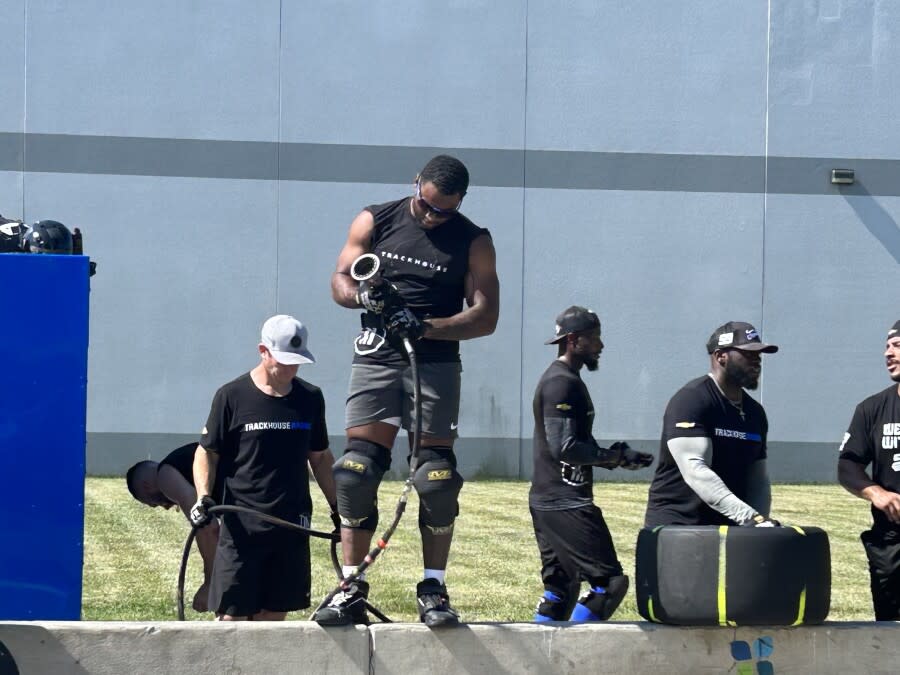New Journey: Former Penn State football star finds new purpose in NASCAR
Journey Brown stood atop the pit wall at Daytona International Speedway, air gun clutched in his right hand, waiting to spring into action. Practice couldn’t simulate this. The roar of the cars, the buzz of the crowd, the anticipation of what was to come.
As Cup cars drove by, Brown tapped the air gun with his left hand four times. Then he surged forward and did what his mother and grandmother told him never to do when he was a child.
He ran in front of a car. And into a new life.
Brandi Seider, who drove 15 hours to be here, stood nearby and recorded the moment on her phone. She and her husband had cried with Brown after his life suddenly changed. Now, she beamed.
“I made a deal with him that his very first race, I didn’t care where it was, I was going to be here,” Seider said.
Brown’s teal-and-white fireproof uniform matched those around him on this steamy Saturday night, but he was unlike anyone else on pit road.
Underneath his uniform were tattoos that memorialized loved ones lost. A tattoo on his left bicep read Everything happens for a reason.
That one was for him.
There had been a time when he carried a football instead of an air gun. When more than 100,000 fans cheered him at Penn State. When he dazzled with one of the greatest running back performances in the Cotton Bowl. When he was headed toward a career in the NFL.
Then it was all gone.
Before the start of his junior year in State College, Brown was diagnosed with a rare heart abnormality that made football too dangerous.
Brandi's husband, Penn State assistant head coach Ja'Juan Seider, heard the diagnosis shortly before Brown and tried to dismiss its cruelty. Brown calls Seider his second father. The ties are deep between the families. Brown also was a roommate with Seider’s son Jaden at college.
“This can’t be true,” Ja’Juan Seider thought. “Not this kid.”

It was 2020 and Brown’s life had been building toward this season at Penn State.
A Pennsylvania kid, Brown was with the state’s top college program after a high school career that saw him rush for 722 yards and 10 touchdowns in a game in 2015. The rushing total is the second-highest nationally in a high school football game, according to the National Federation of State High School Associations. Only a 754-yard performance by John Giannantonio in 1950 is better.
Brown also excelled in track. He won the 2017 Class 3A state title in the 100-meter dash in a record 10.43 seconds. He broke a 32-year-old mark set by Leroy Burrell, who later won a gold medal with the U.S. 4x100-meter relay team at the 1992 Olympics.
Brown was redshirt his first year at Penn State. He shared the running backs room with Saquon Barkley, who would be the second overall pick in the 2018 NFL Draft.
Brown saw limited action in eight games in 2018. He showed what he could do in his redshirt sophomore season in 2019. He had four 100-yard rushing games and capped the year by running for 202 yards against Memphis in the Cotton Bowl, setting a Penn State bowl record.
He was a projected starter in 2020 and in the best shape of his life. The 5-11 Brown weighed about 230 pounds and was running his fastest times. He had hopes of entering the 2021 NFL draft.
“I felt … invincible,” he said.
But he wasn’t.
A preseason medical screening raised concerns. Additional tests confirmed the worst.
Brown was called to Penn State football coach James Franklin’s office in September. When Brown arrived, he saw Franklin joined by Ja’Juan Seider, the team’s trainer, members of the strength and conditioning staff and other team personnel.
Seider tried to hide his emotions. He had been informed only moments earlier of Brown’s condition.
“I was fighting back tears,” Seider said. “I knew I had to be strong for Journey … I had to be a shoulder that he could lean on.”
After Brown was told his football career was over, he laughed. He thought it was a joke.
It wasn’t.
He had hypertrophic cardiomyopathy, a disease that causes the walls of the heart to abnormally thicken. Hypertrophic cardiomyopathy can cause life-threatening irregular heart rhythms or sudden death.
Reality set in. Brown cried. Franklin hugged him.
The tears continued well after the meeting.
“I went to his dorm and cried with him,” Ja’Juan Seider said. “My wife went and cried with him. … We cried for a week or two and then we had to pick it up.”
Still, Brown thought he could come back. He was told that a hit on the football field could cause cardiac arrest and possibly kill him, but that didn’t stop his desire to play.
“This is what I love to do,” Brown said of playing football. “This is something I dreamed of. So, for me, if I were to die on the field, I couldn’t think of any better way to go out.”

Brown’s mindset soon changed.
“I was thinking of my daughter,” Brown said of Aleigha, who turns 4 in October. “I was thinking of my mom. I was thinking about my sister, my family, the people I care about, my fiancee, who was my girlfriend at the time.
“I was just thinking about everybody that I loved very much. I’ve had family members that passed away that were very close to me … It was either have my family feel the way that we always felt when somebody has left us abruptly, or I could control it and still be here and support them in different ways and still help people and find new dreams.”
Before Brown could search for new dreams, he had to let go of his dreams of playing football. Gone was the multimillion dollar NFL contract that would help take care of his family.
“I think the worst part for me, I knew I was so close to making it to my final destination with the NFL,” he said.
When he was told he wouldn’t reach that goal, Brown said it was “the lowest I’ve ever been. I’ve been in some dark places that I would never ever think about now. … I was just in a terrible place.
“I’m always positive. It was a new feeling for me to be that negative and to have those hard feelings.”
Brandi Seider said she and her husband “spent every day that we could encouraging him, praying for him and just trying to help him navigate on to the next chapter of his life. It was one of the hardest things our family had to go through.”
At age 21, Brown had to suddenly figure out what he would do next. And his identity. He had been known as football player Journey Brown for so long that it seemed as if that was his full name. Without football, he was merely Journey Brown.
“It was, more or less, who am I at this point?” he said. “I was looking for my purpose.”
His family helped him find his path.
“You’re not Journey Brown because you play football,” they told him. “You’re Journey Brown because of what you choose to do. What you do makes you you.”
Now that he understood who he was, he still had to find something to do.
A training job in California seemed like the perfect situation before it fell through earlier this year.
Brown was still searching for what to do when he got a phone call from the middle of NASCAR country.

Shaun Peet, pit coach at Trackhouse Racing, had been told of a couple of athletes in the Northeast who could be possible pit crew candidates.
“We go after a certain type of person,” said Peet, who played minor league hockey before becoming a NASCAR pit crew member and then coach. “Something that matters a lot to us is kids that bring energy through the door.”
Peet was intrigued when he heard about Brown. He called and encouraged Brown to visit the team’s race shop in Concord, North Carolina.
Brown’s NASCAR knowledge was limited. He knew of Dale Earnhardt Jr. because a neighbor had a No. 88 flag. Everything else he knew about the sport came from what he saw in the movie “Talladega Nights.”
Brown admits he thought the race shop would be as cluttered and messy as a neighborhood mechanic’s shop. He was surprised to see the large clean spaces where teams worked on cars. He also hadn’t expected to see the diversity in the team’s pit crew members.
Brown found the support at Trackhouse Racing that he had from family and those at Penn State. He moved from Pennsylvania to North Carolina in April to pursue this opportunity.
“So he should be a millionaire and is not,” Peet said, alluding to the NFL career Brown was headed toward before his diagnosis. “He could look at the deck of cards that life handed him and be miserable and think ‘Oh, I should have been this, or I could have done this.’ And he dances through the front door every day. That is an amazing amount of perspective for a young man.
“When he came down and you saw his energy, you were like, ‘Yeah, we can win with someone like this.’”
Regardless of the energy Brown brought, if he wasn’t good enough on a pit crew, it wouldn’t have mattered.
That wasn’t a problem.
“In almost three decades of athletics, I’ve never seen someone move like this kid. Effortlessly,” Peet said, stretching out each syllable. “How he runs. How he jumps. How he does everything.”
Then the team gave Brown an air gun, a few tips and had him change a tire.
“Without question our best first day we’ve ever seen on campus here,” Peet said.
As a development pit crew member, though, there’s no guarantee of how often he’ll be in a race. Trackhouse Racing provides the pit crews not only for the cars of Ross Chastain and Daniel Suarez but also for the cars of AJ Allmendinger and Justin Haley at Kaulig Racing. Those pit crew lineups are set.
Trackhouse Racing’s philosophy is that its developmental tire changers only work with the single lug nut on the wheels on Cup cars. That means those developmental pit crew members won’t work Xfinity or Craftsman Truck Series races because those series have wheels with five lug nuts. That’s a different technique.
That left Brown with only practice until last weekend when Kaulig Racing entered a third car at Daytona for Chandler Smith. Brown was put on that crew.
He made his NASCAR debut at Daytona.

Brown can compete as a tire changer in NASCAR because medication regulates his heart rate. The work pit crew members do comes in short bursts.
He can be the same high-caliber athlete he was in football. He also takes the same approach as when he was a star running back.
At Penn State, coaches harped about paying attention to details. After Brown completed his first pit stop at Daytona, he was thinking about the details of the stop.
“I’m just ready to get the next one out, so I can be perfect,” he said.
Peet said he saw the self-criticism a couple of days after the Daytona race when he asked Brown how he did. Brown said he could have been better in many areas.
“We go see the film and we look at the times, his times are in keeping with everyone they’re racing,” Peet said. “A lot of times we’ve had kids that I’ll ask them how how the night went and (they say) ‘Oh, it went good.’ Then there’s a phone call coming in Monday morning because we had a loose wheel.
“Whereas Journey had a good night and was instantly self-critical to the point where I thought, ‘Oh boy, I’m getting a phone call today.’”
Peet didn’t. There was no loose wheel to report.
The ability, attitude and potential Brown has leads Peet to say that “this kid is going to be the best (tire) changer in NASCAR. And I believe it when he says it. … This kid, he does the things that make him successful.”
Questioned about Brown becoming the sport’s best tire changer, Peet admits that it’s too much pressure to put on Brown but says: “His goal is going to be one of the best in NASCAR.”
It’s something Brown could have never imagined thinking years ago. Instead, his focus was on football.
“When I was playing ball,” Brown said, “the way I felt with my body, my mental (outlook), I felt like I was Superman.
“But now when I have a heart condition and I know I have kind of limitations, so to speak, it’s more like (I’m) Batman, a more realistic type of superhero.”
Brown notes that Batman has to be more resourceful because he cannot match Superman’s abilities, but that doesn’t mean Batman can’t be impactful.
“I feel like for me, that’s what I do in my everyday life,” Brown said. “I just find new ways and strategies to tackle new challenges.”

